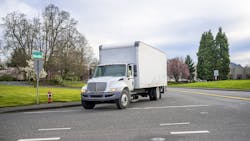As demand grows, fleets don’t have to run on empty
The cost of doing business is high. Yet, to earn more revenue, trucking companies and logistics providers need to take on more business, which inevitably comes with greater risk and added expenditures.
It’s a never-ending cycle. And unfortunately, optimizing operations has become increasingly challenging amid record-high inflation, fuel costs, and lingering labor and supply chain challenges. That said, demand is at an all-time high, with e-commerce and consumer demands unlikely to dissipate.
“Through the pandemic, when the demand was rising, the winners of this period were the ones that digitized their operations prior to the pandemic,” Christoph Herzig, director of product management supply chain solutions for Here Technologies, explained during a recent FleetOwner webinar on how to increase visibility and streamline efficiencies from the middle to the last mile.
“Now, in this challenging world, to actually change your operations and change systems—while your cash flow might allow it, the demand of new business does not allow you to change anything,” he added. “We are seeing with companies that every new order they take on, they are actually losing money because they are already running their entire operation—from the inbound logistics to the distribution center to the last mile—at full capacity.”
When working with logistics providers, Tobias Braun, product manager at Active Logistics, said all parties—from 3PLs to less-than-truckload and truckload carriers—continue to struggle with lack of skilled workers, particularly when it comes to dispatchers, drivers, personnel at the docks, and service personnel. In addition, more and more customers and regulations are requiring sustainable, emissions-reducing freight transport, challenging providers in all-new ways.
“The most important point for companies is they have to analyze their processes and find, for example, if they are repeating very standardized and time-consuming processes,” Braun noted. “Then you have to see if you can find a way to make it better.”
As fleets and logistics providers consider adopting smart planning technology, like route optimization software, Braun emphasized the importance of thinking about leveraging that software to help streamline the entire process of the middle to last mile. He also urges companies to connect to an application programming interface to analyze the loading and unloading of freight.
See also: The impact of automated route planning
“This would be the step after route planning,” Braun added. “You could see the docks and when trucks arrive at terminals, how the unloading process is going, how the reloading process is going, and dispatchers can see that progress and anticipate delays, for example.”
Improving middle- and last-mile profits
In today’s world of not just e-commerce but quick commerce, new delivery experiences are being created. And those delivery experiences are beginning to drive consumer choices, Here Technologies’ Herzig pointed out.
The key to success, Herzig reiterated, is digitizing middle- and last-mile operations.
“For middle mile, you have similar challenges as we see in the last mile; there is a higher chance that something might go wrong,” he advised. “Stay on top of that and provide drivers with the best possible options for meeting their dock schedules. Middle-mile tracking solutions can help make loading docks and tracking capabilities in the distribution facility more efficient. I would not underestimate the efficient middle mile to drive a great last-mile experience.”
Braun also pointed to using technology to integrate predictive ETAs, weather, and traffic control for middle- and last-mile route optimization.
Herzig added that Here Technologies has begun looking into offering multimodal ETA services.
“Yard operations, in many cases, are black boxes for freight forwarders when someone is handing over goods from one carrier to another,” Herzig explained. “To get a grip on these yard operations in a better way, we believe in location intelligence for the yards. So, mapping your yards and being able to understand movement of all the fixed and moving assets in the yard, as well as the traffic in and out, allows you to create the next level of visibility.”
Sustainability pressure grows
Part of operational efficiency these days means sustainability and full-blown freight decarbonization efforts.
See also: Industry reacts to EPA’s truck, engine emissions proposal
“We see there is tremendous pressure from shippers to receive from their logistics service providers the CO2 footprint for a particular transport so they can tie it back to the goods they have been receiving and delivering,” Herzig said. “That provides a tremendous challenge to many fleet operators.”
One of those challenges is the operational undertaking that happens when carriers decide to make the transition to electric from diesel.
“The transition to new drivetrain technology is supported by automation and digitization,” Herzig noted. “You need to have a really good understanding of today’s performance, the tools you’re running, the distances you’re covering, the weights you’re hauling, and how all of that together drives energy consumption and, in the end, carbon emissions.”
“I believe this will be very important for the future,” he added. “In my mind, the future will be electric, it will be connected, and ultimately, automated and autonomous from a drive experience.”
About the Author

Cristina Commendatore
Cristina Commendatore is a past FleetOwner editor-in-chief. She wrote for the publication from 2015 to 2023.
